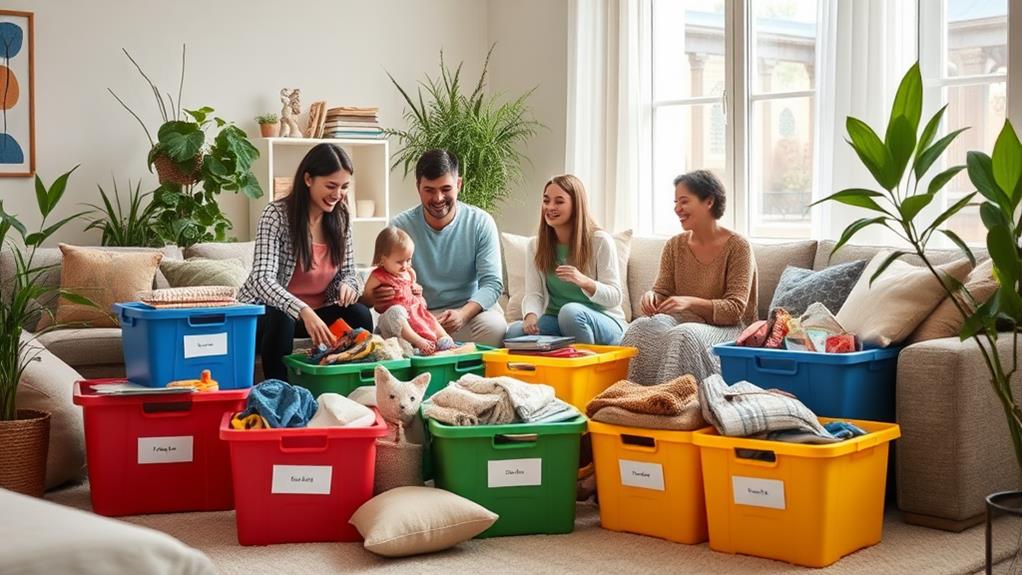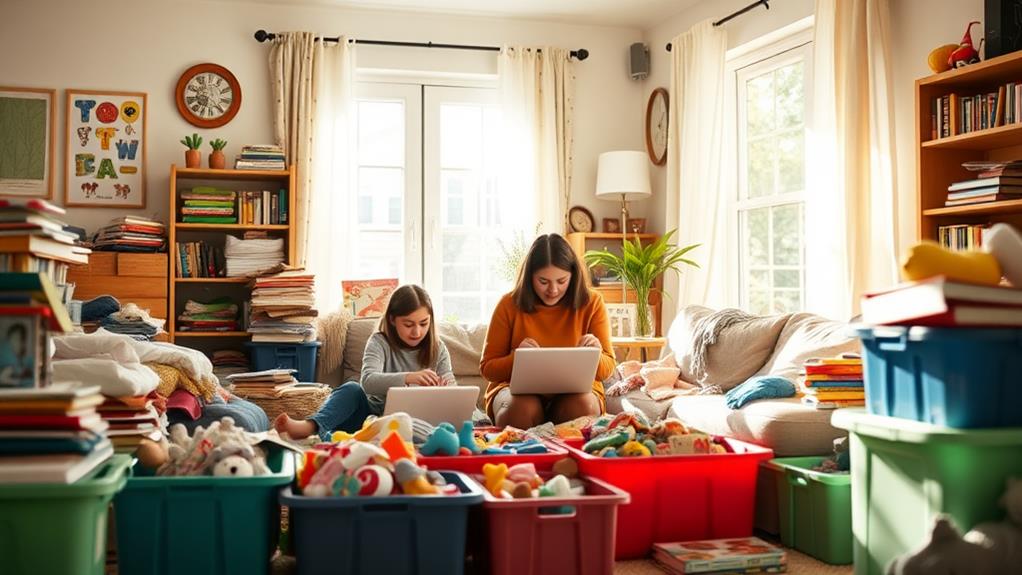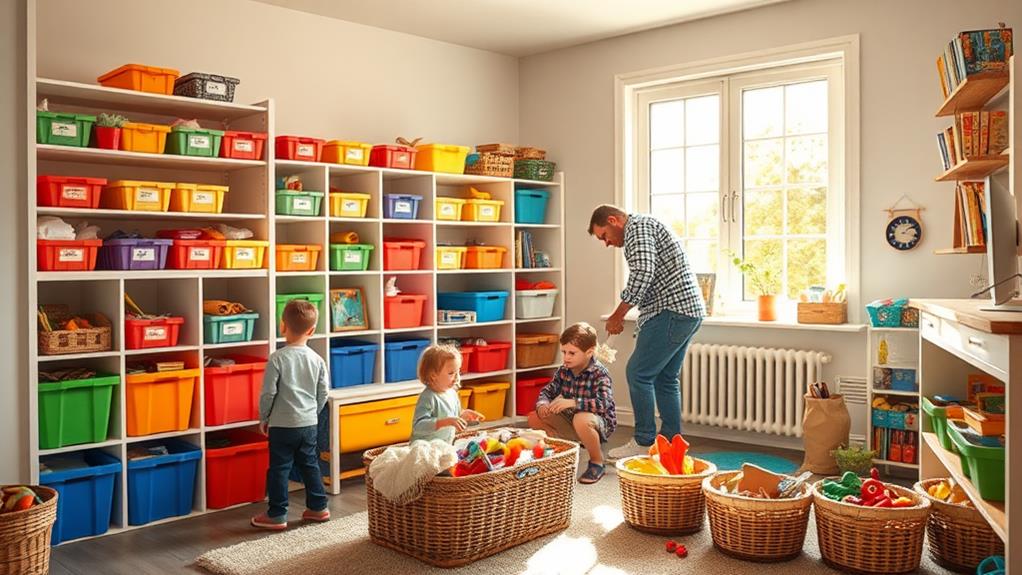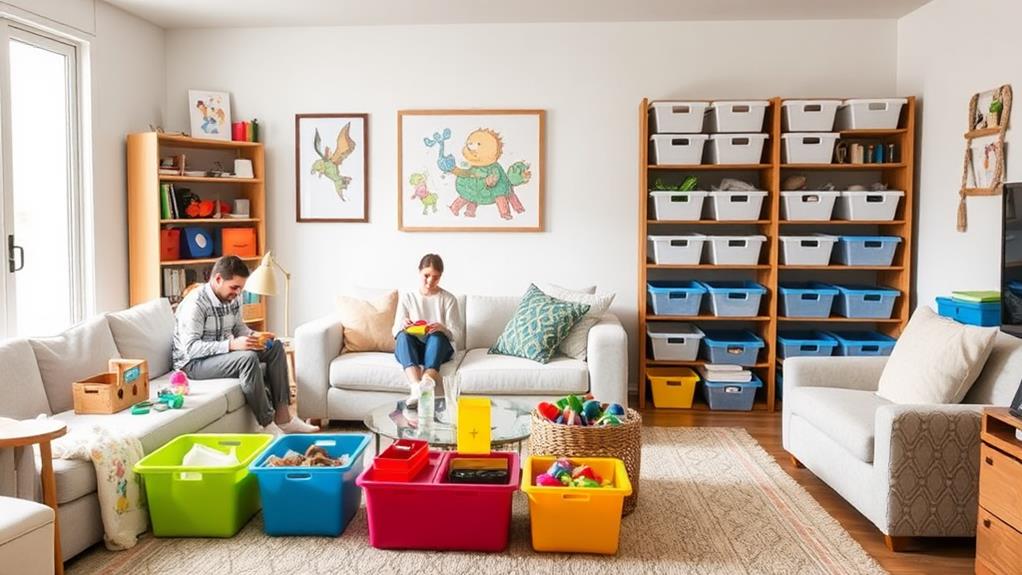You can easily declutter your family’s space by following a few simple steps. Start by preparing everyone mentally and involving them in setting goals. Identify clutter hotspots, like toy shelves and closets, before sorting items into “Keep,” “Donate,” and “Trash” categories. Use the LESS method for layout clarity, sorting effectively, and establishing user-friendly storage solutions. Schedule regular decluttering sessions to maintain order, and don’t forget to celebrate small wins together. By making this a team effort, you’ll encourage responsibility while creating a more inviting environment. Stick around to investigate additional tips that can further streamline your process!
Key Takeaways
- Involve the entire family in setting decluttering goals to foster ownership and teamwork throughout the process.
- Use labeled boxes for sorting items into “Keep,” “Donate,” and “Trash” categories to simplify decision-making.
- Create designated activity zones in the room to maintain organization and enhance functionality.
- Establish a regular decluttering routine, scheduling sessions every few months to manage clutter effectively.
- Implement a “one in, one out” rule to control future accumulation and encourage mindful consumption habits.
Understanding Decluttering Benefits
When you take the time to declutter your family’s space, you’re not just tidying up—you’re opening up a range of benefits that can alter your home environment. By decluttering your kids’ room, you create an organized space that promotes mental clarity and focus. This makes it easier for your children to engage in learning and play activities, enhancing their overall development.
A well-organized room also encourages a sense of responsibility and independence in your children. As they learn to care for their belongings, they gain decision-making skills about what to keep or discard, which are essential life skills they’ll carry into adulthood. Involving them in the decluttering process not only enables them but also strengthens family bonds.
Decluttering creates more space for new toys and activities, resulting in a more inviting environment that sparks creativity and imagination.
Regular decluttering sessions can ease stress for both you and your kids, leading to a more harmonious living space and better family interactions. Embracing these decluttering benefits can convert your home into a nurturing space where everyone thrives.
Identifying Clutter Hotspots
To create a more organized and inviting space for your children, it’s important to pinpoint where clutter tends to accumulate. By identifying these clutter hotspots, you can effectively declutter and organize their rooms, making it easier for everyone to maintain a tidy environment.
Here are some common areas to check:
- Under the bed: This space often hides forgotten toys and items that can be easily misplaced.
- Closets: Outdated clothes and hidden treasures can pile up, making it hard to find essentials.
- Toy shelves: Overcrowded shelves can hinder organization and accessibility, leading to frustration.
- Art corners: Broken or unusable supplies can overflow, stifling creativity and creating chaos.
- General surfaces: Items from various sources can mix together, complicating organization.
Once you’ve identified these hotspots, consider using storage containers to help keep everything in its place.
By understanding where clutter tends to gather, you can better plan how to organize your kids‘ spaces, making it easier for them to find what they need and enjoy their surroundings.
Regularly evaluating these areas will guarantee a more enjoyable, clutter-free environment for your family.
Preparing for Decluttering

Before diving into the decluttering process, it’s essential to mentally prepare both yourself and your children. This mental preparation sets a positive tone for the day, helping everyone accept the task ahead. Start by discussing the decluttering goals with your family, so everyone understands the purpose and feels involved.
Next, set realistic expectations. Remember, decluttering can take time, and you may need multiple sessions to tackle all areas of the room. By acknowledging this, you’ll reduce the chances of frustration or burnout.
Choose a decluttering day when everyone is well-rested to enhance focus and productivity.
Involving children in the decluttering process is important. It cultivates a sense of responsibility and ownership over their belongings, making them more likely to engage positively. Encourage them to make decisions about what to keep and what to let go.
Sorting Items Effectively
Sorting items effectively is an essential step in the decluttering process. Start by grouping similar items together, like toys, books, and art supplies. This visual representation helps you see what you have and makes sorting more manageable.
Employ a two-step sorting process to streamline your efforts:
- Create like-with-like piles
- Make decisions on what to keep, donate, or discard
- Invite your kids to share which items they cherish
- Implement labeled boxes: “Keep,” “Donate,” and “Trash”
- Assess each item’s condition and relevance
Encouraging children to participate nurtures a sense of ownership and responsibility over their belongings.
As you sort through toys and other items, be ruthless. Keep only what sparks joy or serves a genuine purpose in your life.
Making Tough Decisions

Making tough decisions during the decluttering process can feel overwhelming, especially when sentimental attachments come into play. To simplify your choices, use the “Keep, Donate, Trash” method. Start by evaluating each item: if it’s useful and used frequently, it likely deserves a spot in your “Keep” pile. If an item hasn’t been touched in the past year, consider placing it in the “Donate” or “Trash” categories.
Talk to your children about their feelings towards each item. Discussing emotional attachments can help them understand that letting go of certain toys or clothes can open up space for new experiences and memories. Encourage them to participate actively; this promotes ownership and makes the process more meaningful.
Implement a “one in, one out” rule to manage future accumulation. For every new item that enters the room, confirm an old item is either donated or trashed. This habit will ease the burden of making tough decisions in the future.
Involving Kids in the Process
Getting kids involved in the decluttering process can change it from a chore into an engaging activity. By including them, you promote a sense of responsibility and ownership over their belongings while teaching essential decision-making skills.
Here are some fun ways to make decluttering a family project:
- Turn it into a game: Set a timer and see how many toys they can categorize or donate in that time.
- Express feelings: Allow your kids to share why certain items are special, promoting emotional awareness and understanding of letting go.
- Teach organization: Introduce the “one in, one out” rule to encourage mindful consumption and reduce future clutter.
- Create a routine: Regularly schedule decluttering sessions to establish a family habit of maintaining an organized space.
- Celebrate successes: After completing a project, reward your kids with a fun activity or treat to reinforce the positive experience.
Creating Storage Solutions

Once you’ve involved your kids in decluttering, the next step is to create effective storage solutions that support their newfound organization skills. Start by using clear storage containers. These not only enhance visibility but also help your children understand where items belong, making it easier for them to maintain organization.
Next, consider implementing multi-functional furniture. Items like ottomans with hidden storage or beds with drawers can maximize space and reduce clutter in small rooms.
Designated zones for different activities are also essential. For instance, create a reading nook with a small bookshelf and comfy seating, encouraging kids to keep related items together and tidy.
Don’t forget to use vertical space effectively by installing shelves or hooks. This allows for additional storage options while keeping floors clear for play.
Incorporate pull-out bins or baskets for easy access to toys and supplies. This promotes a habit of returning items to their designated spots after use.
Maintaining an Organized Space
Maintaining an organized space requires consistent effort, and it can be a rewarding routine for the whole family. To achieve this, you can implement several strategies that make organization a natural part of your daily life.
- Establish daily tidy-up routines of 5-10 minutes to keep clutter at bay.
- Use clear, labeled storage containers to make it easy for everyone to find and put away items.
- Create designated zones for different activities, like homework, play, and art, so that kids understand where things belong.
- Conduct seasonal purges to reassess your belongings, ensuring that each item still serves a purpose or brings joy.
- Lead by example by maintaining your own organized spaces, inspiring your children to develop similar habits.
Emotional Aspects of Decluttering
Decluttering isn’t just about clearing physical space; it also involves traversing the emotional terrain tied to our belongings. You might find that emotional attachments to toys and items complicate the process, making it essential to acknowledge these feelings.
It’s important to understand that letting go can lead to emotional growth. To ease the shift, consider creating a memory box for special items. This allows you to preserve cherished memories while still decluttering.
When your children express feelings of loss, reassure them that it’s okay to feel this way, and encourage them to reflect on the memories associated with each item.
Additionally, teaching kids about the benefits of sharing and donating can change decluttering into a positive lesson in generosity. This nurtures a sense of community and empathy, turning what could be a struggle into an opportunity for growth.
Utilizing the LESS Method
Embracing emotional growth through the decluttering process sets the stage for a more organized environment.
The LESS Method is a structured approach that not only enhances functionality but also encourages a welcoming atmosphere for your kids.
Here’s how you can apply this method effectively:
- Layout vision and purpose: Define what you want the space to achieve, focusing on essential items.
- Empty all contents: Clear everything out to gain a fresh viewpoint on what you truly have.
- Sort items twice: First, categorize them, then make decisive choices about what to keep or discard.
- Systemize storage: Create user-friendly solutions that make it easy for your children to manage their belongings.
- Label bins: Promote intuitive organization with clear labels, helping kids understand where things belong.
Setting a Decluttering Schedule
Creating a decluttering schedule can greatly streamline your efforts and keep your home organized. Start by designating specific days each month for focused decluttering sessions. This approach guarantees regular maintenance of your spaces and helps you stay on top of clutter before it becomes overwhelming.
Align your decluttering efforts with seasonal changes or major events, like post-holidays or birthdays. These times often bring an influx of items, so it’s the perfect moment to manage what you have.
Involve your family in this process by creating a weekly or bi-weekly routine. Dedicate just 10-15 minutes each session for quick decluttering tasks; you’ll be surprised at how much you can accomplish together.
Utilize a calendar or planner to track decluttering goals and progress. This not only keeps you accountable but also serves as a visual reminder of your achievements.
Consider setting aside dedicated time during school breaks or long weekends to tackle larger areas of clutter. By breaking the process into manageable chunks, you’ll find it’s less intimidating and more enjoyable.
Accept this schedule, and you’ll cultivate a more organized and peaceful home.
Celebrating Small Wins
Small victories during the decluttering process can fuel your motivation and enthusiasm, making the experience feel less intimidating.
Celebrating small wins is essential for maintaining momentum and reinforcing a positive mindset. When you recognize achievements, no matter how minor, you enable yourself and your family to take on bigger tasks ahead.
Here are some ways to celebrate those small steps in your decluttering expedition:
- Complete a Single Drawer: Acknowledge the effort by enjoying a family treat.
- Take Before-and-After Photos: Visual proof of your progress can be incredibly rewarding.
- Set Mini-Goals: Break larger tasks into smaller ones, celebrating each completion.
- Create a Reward System: Plan a family outing or special activity after finishing a designated space.
- Share Success Stories: Talk about your achievements with friends or family to reinforce positive behavior.
Long-Term Decluttering Strategies

While decluttering might feel overwhelming at times, implementing long-term strategies can make the process manageable and effective.
Start by establishing daily tidy-up routines that take just 5-10 minutes. This small commitment encourages consistent organization and prevents clutter from piling up.
Next, schedule seasonal purges to reassess toys and clothing. Regularly evaluate what your family truly needs and uses, ensuring you keep only the essentials.
Consider using a declutter bin to collect items that are no longer needed. This proactive approach helps you stay on top of your belongings and prevents buildup.
Designated storage locations are vital. Assign specific places for all items, making it easier for children to return things to their proper spots. This not only maintains order but also teaches kids responsibility and organization.
Lastly, lead by example. Maintain your own personal organization to inspire your children to develop their own habits of tidiness.
Conclusion
By embracing these decluttering steps, you’re not just tidying up; you’re creating a sanctuary for your family. Remember, every small victory is a stepping stone toward a more organized space. Like a gentle breeze clearing away storm clouds, each effort you make lightens your home’s atmosphere. Stick to your schedule and keep the momentum going, and soon, you’ll find that a clutter-free environment cultivates peace, creativity, and connection for everyone. You’ve got this!
Join our list
Subscribe to our mailing list and get interesting stuff and updates to your email inbox.

